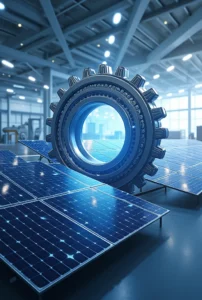Solar energy is quickly revolutionizing how our homes and enterprises are lit. Bifacial solar panels are among the latest advancements that can be installed to produce electricity. Unlike conventional panels, these are symmetrical to harvest light on both surfaces and provide a higher return. Now it’s time to consider everything you’ve ever wanted to know about bifacial solar panels.
What is a Bifacial Solar Module?
Dual-sided solar panels produce energy on the front and rear faces of the panel. The first layer captures direct sunlight, and the second layer uses reflected light, for instance, on the ground.
Such designs are highly efficient because of two-sided utilitarianism. They are ideally suited when it comes to ensuring maximum generation of energy in different settings.
How do bifacial solar panels work?
The design is key. The photovoltaic cells appear on both sides of the panel. These cells are photovoltaic, meaning they collect light and turn it into direct electric current.
Most microphone manufacturers prefer highly reflective surfaces.• Paint the surface white or use reflective paint; rear-side absorption is more significant.• Large surface areas, such as the car park areas, have enhanced reflection of sunlight. The panel contains photovoltaic cells. These cells absorb light and convert it into electricity.
Reflective surfaces enhance performance. For instance:
• White Concrete or reflective paint increases rear-side absorption.
• Open spaces, like parking lots, maximize sunlight reflection.
Advantages of the Bifacial Solar Panels
1. Higher Energy Output
These bifacial panels can give up to 30 more energy than the standard power-producing panels. Again, an extra generation on the rear side is quite a significant improvement.
2. Durable Construction
The majority of bifacial panels can have a glass-on-glass structure. This makes them stronger and weather resistant to all extreme weather.
3. Longer Lifespan
The materials used do not flex, creating strength; therefore, the structure protects the item from damage due to flexing. A vast number of panels last more than thirty years, and they do not exhibit signs of inefficiency.
4. Flexible Installation Options
Bifacial panels can be integrated into both roofs, as well as in open ground systems or even within the façade of structures.
The Uses of Bifacial Modules
1. Commercial Buildings
Numerous business applications utilize bifacial panels, especially for large-scale power generation. The appearance of these structures is evident in any city.
2. Residential Installations
As a result, bifacial systems are helpful to homeowners in achieving the highest level of energy savings. Contemplative spaces function best when the yards are open.
3. Solar Farms
Bifacial panels are suitable for incorporating into solar farms. This way, both sides enjoy the sun as a few installations are raised high above the ground in this country.
Limitations to Consider
No technology is perfect. Here are some challenges:
Higher Costs: Bifacial panels are more costly than their mono facials counterparts, especially initially.
Complex Installations: The positioning factor is the next component we should touch.
Dependency on Reflective Surfaces: The results obtained depend on the type of ground material and its environment.
Factors Affecting Performance
1. Albedo Effect
The albedo effect estimates the reflection percentage of a surface. High reflectance colors indicated white or shiny results in a higher bifacial ratio.
2. Tilt Angle
The orientation of these systems impacts the levels of produced energy. All panels should be oriented towards where they can afford to be most exposed to sunlight.
3. Height of Installation
Raising the panels improves the amount of light harnessed on the rear side.
Cost of Bifacial Solar Panels
Bifacial panels are significantly more costly than conventional ones.•. Panel costs range between $0.60 and $1 per watt.• The installation cost is extracted from the labour expense and the materials used to install the system. It is pricier than traditional ones. Here’s what to expect:
• Panel costs range from $0.60 to $1 per watt.
• Installation costs depend on labour and materials.
However, bifacial panels are slightly more expensive than mono PERC panels, though the former is financially rewarding in the long run.

Should I Buy Bifacial Solar Panels?
That is true in many situations, but they are worth the investment.• Your location is sunny – If, for some reason, you rarely find yourself in the sunshine, your location provides enough sunlight for plants to grow.• You have reflective surfaces like sand, water, or Concrete.• Your goal should be to get the best possible performance to benefit your organization long term. Investment in many cases. Consider bifacial panels if:
Your location receives abundant sunlight.
You have reflective surfaces like sand, water, or Concrete.
You want a high-performance system with long-term benefits.
Conclusion
Bifacial solar panels are the solution for renewable assets or electricity. They offer offload higher efficiency, durability and flexibility in completing activities. It is true because even though initial costs are incurred, the benefits are far more lasting than the investment.
Going for bifacial panels should be a new plan for anyone interested in increasing solar power. Jump into the future of energy now!
Also read about: What Is the cost of New Roofing?


One Comment on “Bifacial Solar Panels: A Complete Guide”
Comments are closed.